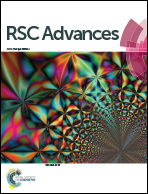A green, simple and cost-effective approach to synthesize high quality graphene by electrochemical exfoliation via process optimization
Abstract
This research focuses on manufacturing graphene nanosheets (GNSs) using an electrochemical exfoliation method. Through tuning the synthetic parameters, such as the composition of electrolytes, concentration of the electrolyte, KOH/H2SO4 ratio, and applied voltage and current density, the relationships between the material’s characteristics and synthetic parameters were studied. The physical and chemical properties of as-synthesized GNSs were systematically studied using scanning electron microscopy (SEM), high resolution transmission electron microscopy (HR-TEM), X-ray diffraction (XRD), atomic force microscopy (AFM), Raman spectroscopy (Raman), Fourier transform infrared spectroscopy (FTIR) and X-ray photoelectron spectroscopy (XPS). Among the synthetic parameters, current density plays a very important role in this exfoliation process. Under the optimal current density of 0.11 A cm−2, we successfully synthesized high quality GNSs with a D/G ratio of 0.061, which is far superior to the reported values of other groups. The results indicate that a green, simple and cost-effective exfoliation process has been successfully developed in this study.


 Please wait while we load your content...
Please wait while we load your content...